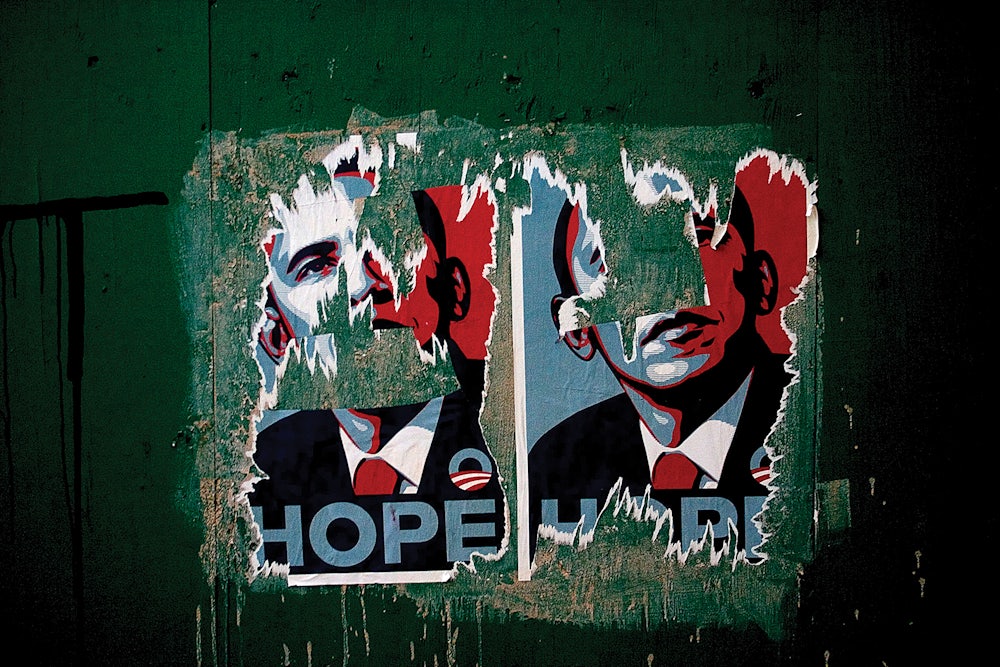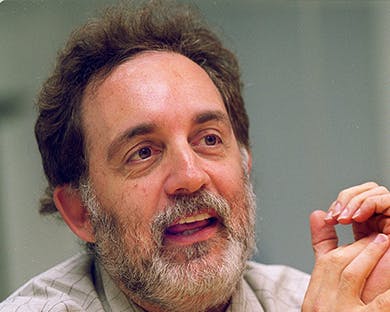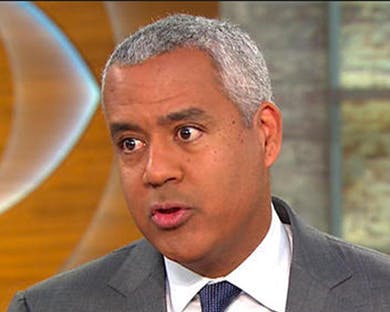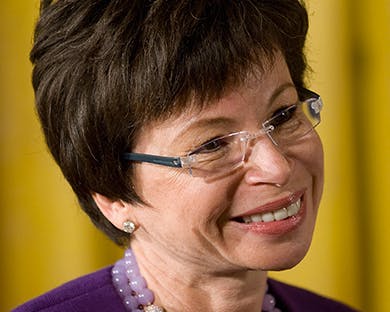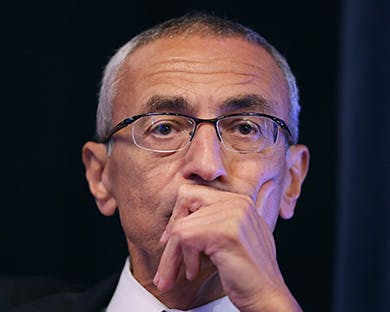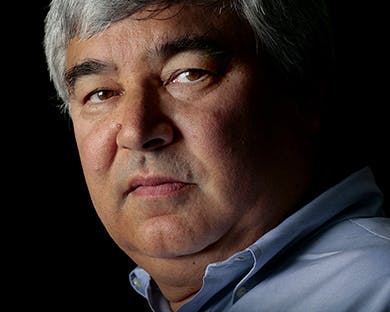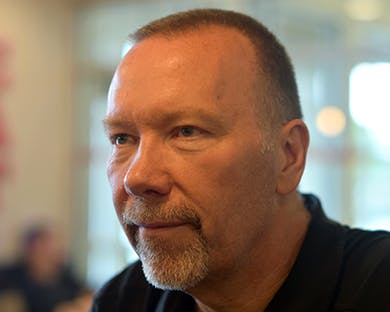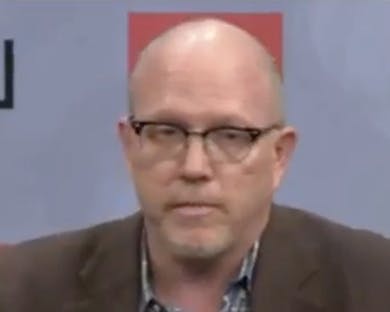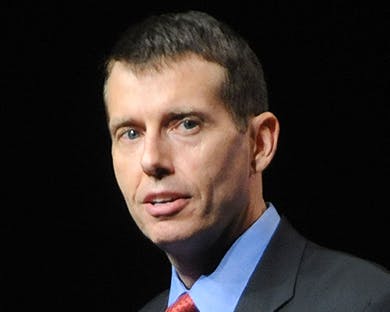On July 20, 2008, Mitch Kapor, the creator of Lotus 1-2-3 and a longtime denizen of Silicon Valley’s intellectual elite, dialed in to a conference call hosted by Christopher Edley Jr., a senior policy adviser to Barack Obama’s presidential campaign. Joining them on the line were some of the world’s top experts in crowdsourcing and online engagement, including Reid Hoffman, the billionaire co-founder of LinkedIn, and Mitchell Baker, the chairman of Mozilla. Drawing on Kapor’s influence, Edley had invited them to join a “Movement 2.0 Brainstorming Group.” Together, they would ponder a crucial question: how to “sustain the movement” should Obama, who was still a month away from accepting the Democratic nomination, go on to win the White House.
Edley had been a personal friend of Obama’s since his days teaching him at Harvard Law School. Their kinship had been underscored the previous summer, when Obama had invited Edley to the Chicago apartment of Valerie Jarrett, the candidate’s closest confidant, to deliver a stern lecture to the seasoned political operatives who were running his underdog bid for the presidency. The campaign team had Obama on a relentless pace of town halls and donor calls, and Hillary Clinton had been besting him in the early primary debates. Both Barack and Michelle Obama were unhappy. According to John Heilemann and Mark Halperin’s account in Game Change, Edley urged Obama’s campaign managers to schedule fewer rallies and fund-raisers, and allow the candidate more time to think and develop innovative policy ideas.
The intervention, delivered with a full-blown harangue telling the troika managing the campaign—David Axelrod, David Plouffe, and Robert Gibbs—to “get over yourselves,” was deeply resented by the political professionals; in his memoir, Believer, Axelrod would later call Edley “systematically antagonizing.” But Jarrett and Michelle Obama, who was also in the meeting, hung on Edley’s every word. “He’s channeling Barack,” Jarrett thought, according to Game Change. Jarrett told Axelrod she thought Edley’s fiery presentation had been “brilliant.”
Now, a year later, Edley had been moved over to Obama’s still-secret transition team, helping to map out policy and personnel on education, immigration, and health care. It was a better fit for Edley, a dapper and soft-spoken law professor with a salt-and-pepper beard, who had served in senior policy-making roles under Jimmy Carter and Bill Clinton. “Although I have worked in five presidential campaigns,” he told me recently, “I hate them because there is never enough emphasis on policy.” But Edley found himself newly motivated by a single big political idea, born in part from his past experience trying to win policy fights. What if Barack Obama could become not only the first black man elected president, but the first president in history to organize an enduring grassroots movement that could last beyond his years in office?
By that point in the race, there was every reason to think that Obama could build a lasting grassroots operation. His political machine had already amassed more than 800,000 registered users on My.BarackObama, its innovative social networking platform. “MyBO,” as it was known, gave supporters the ability—unthinkable in a traditional, top-down political campaign—to organize their own local groups, campaign events, and fund-raising efforts. Its potential for large-scale organizing after the election was vast—and completely without precedent in American politics. By Election Day, Obama’s campaign would have 13 million email addresses, three million donors, and two million active members of MyBO, including 70,000 people with their own fund-raising pages. This wasn’t just some passive list of campaign supporters, Edley realized—it was an army of foot soldiers, seasoned at rallying support for Obama’s vision of change.
“As the primary season wound down, it struck me that the campaign’s broad-based engagement via the internet could evolve into a powerful tool to shape progressive politics at the national, state, and local levels,” Edley recalls. “One goal would be to support an Obama presidency. But the agenda would be far broader.”
After discussing his idea with his wife, Maria Echaveste, who had served as White House deputy chief of staff under Bill Clinton, Edley turned to his friend Kapor, a digital pioneer and progressive activist who was widely seen as a folk hero of the computer revolution. “I knew that Mitch would be an indispensable partner to judge the merits of the general idea and help figure out some details,” Edley says. “I also realized, quite quickly, that Mitch had amazing contacts in that world whom we could enlist for the project.”
Opening the July brainstorming session, Edley framed the stakes sharply, according to notes he prepared for the meeting and a summary he wrote afterward. “On the morning of November 5,” he told the assembled tech leaders, “imagine saying to millions of donors, new voters, volunteers: ‘Thanks for everything; so long.’” Instead, he urged, “Imagine a way to transfer/transmute all of that involvement into a new mechanism or set of instrumentalities through which people can feel a heightened and more powerful kind of civic engagement with each other and with Obama and other leaders. And vice versa.”
Edley echoed what many progressives were beginning to believe was possible with a President Obama: “There is a rare opportunity to have a citizen movement heading in the same progressive direction as an incumbent president.” According to his notes, the Silicon Valley luminaries on the call agreed. “Most felt it would be an unacceptable loss not to take advantage of the rare alignment of an incumbent President with a progressive agenda, and an online constituency of donors and supporters who can press for change against the inevitable upsurge of entrenched special interests which will resist it.”
As we now know, that grand vision for a postcampaign movement never came to fruition. Instead of mobilizing his unprecedented grassroots machine to pressure obstructionist lawmakers, support state and local candidates who shared his vision, and counter the Tea Party, Obama mothballed his campaign operation, bottling it up inside the Democratic National Committee. It was the seminal mistake of his presidency—one that set the tone for the next eight years of dashed hopes, and helped pave the way for Donald Trump to harness the pent-up demand for change Obama had unleashed.
“We lost this election eight years ago,” concludes Michael Slaby, the campaign’s chief technology officer. “Our party became a national movement focused on general elections, and we lost touch with nonurban, noncoastal communities. There is a straight line between our failure to address the culture and systemic failures of Washington and this election result.”
The question of why—why the president and his team failed to activate the most powerful political weapon in their arsenal—has long been one of the great mysteries of the Obama era. Now, thanks to previously unpublished emails and memos obtained by the New Republic—some from the John Podesta archive released by WikiLeaks, and others made available by Obama insiders—it’s possible for the first time to see the full contours of why Movement 2.0 failed, and what could have been.
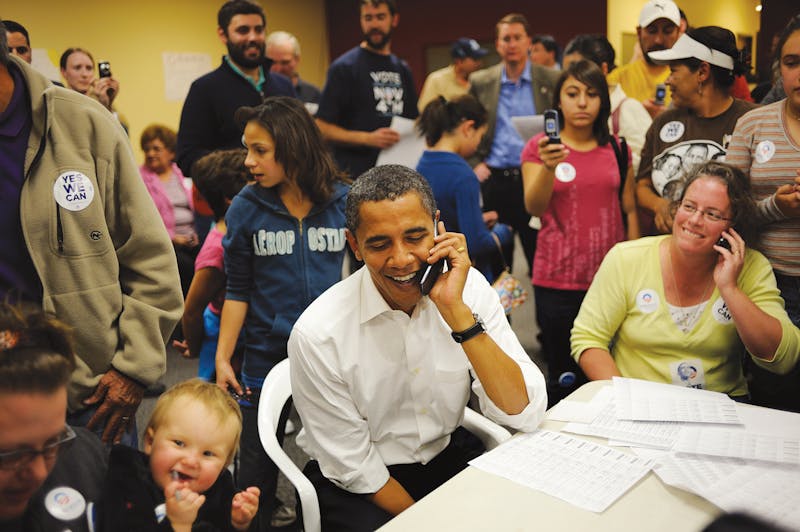
In the midst of the 2008 campaign, the idea for Movement 2.0 seemed both obvious and inevitable. Obama himself recognized that he was sitting atop an organizing juggernaut. Speaking to hundreds of his core staffers in June, Obama praised them for building a campaign machine that had just taken down Hillary Clinton. “Collectively, all of you—most of whom are I’m not even sure of drinking age—you’ve created the best political organization in America, and probably the best political organization that we’ve seen in the last 30 to 40 years,” Obama told them. “That’s a pretty big deal.”
Movement 2.0 gathered steam quickly. In the wake of the initial brainstorming call, Edley connected Mitch Kapor with law professor Mark Alexander, a senior Obama adviser, and gave them the job of chairing the project. Kapor was excited. “Mark and I are exchanging email brain dump to try to surface big question and big priorities overall, speaking by phone, and meeting all day next Tuesday in New Jersey to do Vulcan mind meld,” he emailed two colleagues. “Already Mark and I have shared vision it’s huge, and will go far beyond normal January end of transition.”
Kapor and Alexander dived into the task. They spoke with Bob Bauer, the campaign’s legal counsel, about how to structure a new organization after November. They had several meetings with the architects of Obama’s online operation, including Slaby, the chief technology officer; his boss, Joe Rospars, the new media director; and Chris Hughes, the online organizing director. They dug into the details of how the campaign had built and managed its online network, and sketched out a way to transition it forward.
With barely three months left until Election Day, Kapor—a veteran of many tech startups—knew that time was short for such an ambitious effort. “Coordination is going to be vital,” he emailed Edley on July 23, “and I know campaign time and attention is going to be very limited, so the sooner we can figure out what the ‘bridge’ is between campaign and transition with respect to online community, and whether it’s a footpath or a highway, the better. I am worried that as each day goes by without knowing anything about what we on the transition side might be building and how it does or does not connect, the deadline pressure to actually deliver on time gets worse and worse.”
A few weeks later, on August 18, Edley sent a progress report to John Podesta and the other two co-chairs of Obama’s transition board, Valerie Jarrett and Pete Rouse. “Campaign folks are joined at the hip with this effort (Rospars, Slaby, others),” Edley assured them. “The technical discussions about the software platform, etc., are moving quite well.” While he acknowledged that “the Senator” would ultimately have to sign off on the plan, Edley—confident that he was still channeling his old friend’s wishes—said he didn’t “see any particular hurry about it.” The candidate, he understood, had a few other things on his mind.
Edley attached the initial concept document for Movement 2.0. It outlined an audacious vision: to create “a new ‘home place’ for Obama supporters” that would be ready to go, the day after the election. The new entity would be closely aligned with Obama but independent of the party and his re-election campaign. “Think of it for now as AFO (Americans for Obama),” the memo declared, envisioning it as the “principal means for continuing the active participation of people in the Movement.” AFO would not simply whip up support for Obama’s legislative agenda—it would “gather the input to help shape it.” It would “be a place where Obama supporters can come together, affiliate and organize for change using cutting-edge online tools that will create and support a new and deeper form of civic engagement.”
Critically, the Movement 2.0 team envisioned AFO as a tax-exempt organization that would operate free of the Democratic National Committee. “Mitch and I argued that to make the movement ‘authentic’ and entrepreneurial,” Edley says, “it would have to be built outside of the DNC—which has institutional commitments and incumbent allegiances that will always be a fact of party life.” The team concluded by asking for permission to raise $250,000 to set up a staff infrastructure and develop the web site. The founding board would include Edley, Kapor, Alexander, and Podesta.
Podesta decided to circulate the concept document to higher-ups in the campaign. He asked Pete Rouse, Obama’s Senate chief of staff and key political consigliere, to forward the memo to Steve Hildebrand and Paul Tewes, partners in a political consulting firm who had risen to positions at the top of Obama’s organization. Hildebrand was the deputy national campaign manager, and Tewes, after directing Obama’s Iowa campaign, was now running the DNC on the candidate’s behalf. Podesta had a simple question for them about Edley’s plan: He wanted to “see if they care whether this goes forward to a planning stage.”
That was the moment when Movement 2.0 began to stall.
The proposal had started with the campaign’s technology team and true believers, but now it had landed in front of two consummate Washington insiders. Hildebrand came to like the idea; creating a movement free from the DNC, he believed, would put more pressure on Congress to implement Obama’s agenda. But where others had seen great possibility, Tewes saw potential disaster. Four days later, he wrote to Rouse and his colleague Hildebrand:
As both of you know, I have many concerns about this..... as a lover of “Party” I really don’t like this.
I think the decision needs to be made and discussed on “this vs. party” or “this and party.” The discussion should focus on—What is best for Barack Obama, his politics, his agenda and his future.
If the first step is to move outside the party with your organization, the political ramifications and “future” ramifications need to be thought through. Further, a discussion should be had of party over this—why and why not?
Marching into this seems premature and secondly creating something before hand (before e-day) has appearance problems in my opinion.
I would ask that we postpone any of this till after the convention and do a little gathering where we can discuss. Please.
Rouse forwarded Tewes’s response back to Podesta. Podesta, in turn, sent it along to Edley with a pithy comment: “Let’s discuss Monday. Obviously some heartburn with the political crowd.”
There was plenty in Movement 2.0 to inspire heartburn in that crowd. In Silicon Valley terms, Obama 2008 had “disrupted” presidential campaigns, demonstrating how an underdog candidate could defeat a more experienced opponent by changing the terms of the game and empowering millions of people in the process. Now, it seemed, the Obamaites and their tech wizards wanted to disrupt the Democratic Party, diverting money and control from the DNC into an untried platform, while inviting “input,” and possibly even organized dissent, from Obama’s base. Earlier that summer, activists unhappy with Obama’s flip-flop on warrantless surveillance had used MyBO to build a group of more than 20,000 vocal supporters, earning national press and compelling a response from the candidate. What if Obama’s base didn’t like the health care reform he came up with, and rallied independently around a single-payer plan? Besides, grassroots movements, no matter how successful, don’t reliably yield what political consultants want most: money and victories for their candidates, with plenty of spoils for themselves. For insiders like Tewes, Movement 2.0 was a step too far.
Edley knew that Tewes’s blowback spelled trouble. On August 24, the day before Obama’s triumphal convention began in Denver, he emailed Podesta to express hope that it was just a “misunderstanding.” He asked Podesta to keep the issue off the agenda of the transition board’s next meeting until they figured out what to do. Podesta agreed. “I think we should [n]ot raise at all tomorrow,” he told Edley, “and come up with seperate [sic] plan on how to proceed.”
Looking back, Edley says now, Podesta made a tactical error by sharing the plan with party regulars like Tewes and Hildebrand before it had garnered more high-level support in the campaign. “John should’ve realized that of course the DNC would have competitive objections,” he says. “Our proposal would’ve created, at least in our dreams, yet another set of political forces and policy energy. At the time, I just didn’t realize the powerful pull that the architects of the Obama ‘movement’ would feel away from movement building and toward paranoid possession of the conventional trappings of political power. If you’re not really that committed, as a matter of principle, to a bottom-up theory of change, then you will find it nonsensical to cede some control in order to gain more power.”
It would be five long weeks later, on October 2—just a month before Election Day—before any reference to Movement 2.0 would surface again in Podesta’s emails. By that time, radical revisions had been made to appease the “political crowd.” Chris Lu, the transition team’s executive director, circulated a revised concept memo to Podesta and its board, in preparation for an all-day meeting. It was a far cry from Edley’s original call for a “citizen movement.” Instead, the memo explained, “we recommend a new, integrated approach to the Movement 2.0 work, in complete coordination with the ongoing efforts of the DNC, to plan for the continued growth and development of the online-offline community in support of Barack Obama and the Democratic Party, our candidates and issues.”
Gone was the idea of a new organization, independent of the DNC. “A key working assumption,” the memo stated, “is that we should affirmatively empower Barack Obama as the head of the Party, and in the process strengthen both him and the Party. All Obama politics should be filtered through the DNC, and all Party politics”—including existing organizations that support candidates for Congress and statehouses—“should be filtered through the DNC. This all serves the agenda of one person, Barack Obama.”
The original backers of Movement 2.0 had been sidelined. “I had nothing to do” with the new memo, Edley says. “I guess they liked our name for it, but chose to pervert the idea to something quite conventional and, forgive me, trivial. To me, real movement building had to be about defining and advancing progressivism, not a communication strategy from the West Wing basement costumed as faux movement. The kind of movement we wanted would have helped Obama a great deal, without making it all about him. After all, even Obama’s campaign wasn’t only about him or his policy platform.”
Edley and his cohorts weren’t finished yet. The idea of keeping Obama’s online loyalists involved and active had not entirely died; the new memo called for moving quickly to enable the campaign to keep engaging its grassroots supporters after the election. “Steps should be taken now to ensure this possibility does not evaporate, leaving no vehicle for community in the short-term,” the memo read. But there was no proposed budget for that to happen—just a call for the formation of a new working group for Movement 2.0, to pull all the stakeholders together. That group never materialized.
The revised memo was not the only postelection plan being considered. Julius Genachowski, co-chief of the transition team’s “Technology, Innovation, and Government Reform” group, wanted to launch a White House web site aimed at engaging the public in policy discussions. The TIGR group was a powerhouse of wonks, many of whom were headed into top positions in government, and its planning memo ran to 12,500 words, compared to just 1,500 for the revised Movement 2.0 proposal. The result—in the middle of a heated campaign and a global economic meltdown—was widespread confusion about what would happen to Obama’s campaign machine after Election Day.
On October 10, Edley told Kapor and Alexander by email that Pete Rouse had “agreed to try to arbitrate all of this.” But five days later, Edley reported that he was getting nowhere. “I am frustrated beyond words on this. Will work it hard today. I think since the campaign team has rigged something for the transition period they just keep back-burnering the longer run issue.” A day later, Kapor reported back that Rouse was “too busy (w/ debate prep and all) to deal with M2.0.… I think fundamentally it’s not going to be a priority until after the election.”
Ultimately, the transition team agreed on only one project: build a simple postelection site, to be called Change.gov, as a place where people could learn more about the transition’s plans and job-seekers could submit their résumés. In the end, there would be no “footpath” or “highway,” as Mitch Kapor had envisioned, for transitioning Obama’s two million supporters on MyBO into a new platform. There wasn’t even a rope bridge.
But Kapor didn’t give up. In late October, he spoke to Jim Messina, chief of staff to campaign manager David Plouffe, and came away convinced that both Plouffe and Rouse now backed the original vision for the movement. “Importantly, Messina said Plouffe is not only on board but wants his sole responsibility after the election to be getting M2.0 going,” Kapor emailed Edley and Alexander on October 23. Even if it was too late to build on the momentum from Election Day, there was still a chance that Movement 2.0 would take wing.
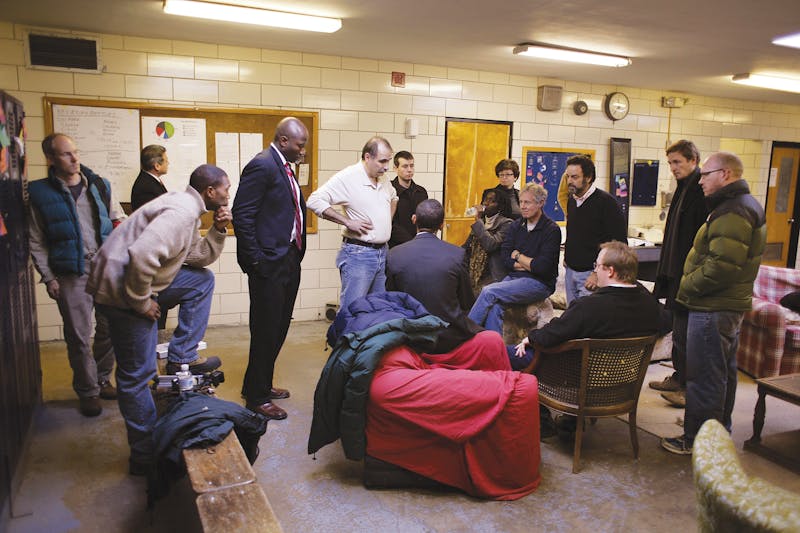
On November 5, the day after Obama’s victory, his headquarters in Chicago was deluged with phone calls and emails from supporters asking for guidance on how to keep going. Exactly as Edley had feared, no answers were forthcoming—not even about whether the tens of thousands of volunteers who had built personal fund-raising groups on MyBO would be able to continue them. “We’re all fired up now, and twiddling our thumbs!” wrote one frustrated volunteer from Pennsylvania. “ALL the leader volunteers are getting bombarded by calls from volunteers essentially asking: Nowwhatnowwhatnowwhat?”
It wasn’t until three days after the election that Chris Hughes, the campaign’s director of online organizing, put up a post on his personal MyBO page. “The site isn’t going anywhere,” he promised supporters. “The online tools in My.BarackObama will live on. Barack Obama supporters will continue to use the tools to collaborate and interact.” As a stopgap, that was reassuring to grassroots organizers who had used the site to build strong local networks. But it wasn’t a plan. There was no plan.
One person, however, seemed to understand that such half-measures wouldn’t be enough: the president-elect. The same day Hughes posted his message, Obama reached out to David Plouffe. Unlike other top operatives from the campaign, the campaign manager had decided not to follow Obama into the White House, but to take time off to be with his family before returning to political consulting. His daughter was born in the early hours of November 7, and Obama called him that morning.
“I know you’re disappearing for a while to change diapers and play Mr. Dad,” Obama told Plouffe, “but just make sure you find time to help figure out how to keep our supporters involved. I don’t think we can succeed without them. We need to make sure they’re pushing from the grassroots on Washington and helping to spread what we’re trying to do in their local communities. And at the very least, we have to give them the opportunity to stay involved and in touch. They gave their heart and soul to us. This shouldn’t feel like a transactional relationship, because that’s not what it was. I want them along for the ride the next eight years, helping us deliver on all we talked about in the campaign.”
Three days later, Kapor emailed Edley and Alexander, frustrated that no progress was being made. “What is needed now,” he wrote, “is for the President-elect and his designees to decide how to move forward with Movement 2.0.” Would the group be independent or part of the DNC? Who would run it? How would it interact with the White House? “I don’t see how anything can happen until the project is given a green light and the basic issue of structure and leadership is settled by those with the power to do so,” Kapor concluded. “In other words, someone please just make a decision.”
Plouffe led Obama’s supporters to believe that the decision was in their hands. On November 19, he emailed a survey to everyone on the campaign’s list. “You’ve built an organization in your community and across the country that will continue to work for change,” Plouffe told them, “whether it’s by building grassroots support for legislation, backing state and local candidates, or sharing organizing techniques to effect change in your neighborhood. Your hard work built this movement. Now it’s up to you to decide how we move forward.”
Obama’s army was eager to be put to work. Of the 550,000 people who responded to the survey, 86 percent said they wanted to help Obama pass legislation through grassroots support; 68 percent wanted to help elect state and local candidates who shared his vision. Most impressive of all, more than 50,000 said they personally wanted to run for elected office.
But they never got that chance. In late December, Plouffe and a small group of senior staffers finally made the call, which was endorsed by Obama. The entire campaign machine, renamed Organizing for America, would be folded into the DNC, where it would operate as a fully controlled subsidiary of the Democratic Party. Plouffe stayed on as senior adviser, and put trusted field organizers Mitch Stewart and Jeremy Bird in charge of the new group. Bird says the OFA team was never even told about the idea for Movement 2.0. “None of these documents were even shared with us,” he says. “I’m not sure the senior staff on the campaign even knew they existed.”
Obama unveiled OFA a week before his inauguration. “Volunteers, grassroots leaders, and ordinary citizens will continue to drive the organization,” he promised. But that’s not what happened. Shunted into the DNC, MyBO’s tools for self-organizing were dismantled within a year. Instead of calling on supporters to launch a voter registration drive or build a network of small donors or back state and local candidates, OFA deployed the campaign’s vast email list to hawk coffee mugs and generate thank-you notes to Democratic members of Congress who backed Obama’s initiatives. As a result, when the political going got rough, much of Obama’s once-mighty army was AWOL. When the fight over Obama’s health care plan was at its peak, OFA was able to drum up only 300,000 phone calls to Congress. After the midterm debacle in 2010, when Democrats suffered their biggest losses since the Great Depression, Obama essentially had to build a new campaign machine from scratch in time for his reelection effort in 2012. (Plouffe and Messina declined requests to speak about Movement 2.0; Axelrod, Podesta, and Rouse said they had no comment.)
Republicans, on the other hand, wasted no time in building a grassroots machine of their own—one that proved capable of blocking Obama at almost every turn. Within weeks of his inauguration, conservative activists began calling for local “tea parties” to oppose the president’s plan to help foreclosed homeowners. FreedomWorks, an antitax group led by former Representative Dick Armey, and Americans for Prosperity, funded by the Koch brothers, quietly coordinated hundreds of nationwide demonstrations designed to look like a spontaneous populist uprising. When members of Congress went home for the summer to hold town hall meetings with their constituents, they were confronted by well-organized and disruptive protests over health care reform. The grassroots discontent that Obama had harnessed so skillfully in 2008 now belonged to the right.
“Killing OFA reduced the possibility of competing for the hearts, minds, and votes of the Tea Party disaffected,” says Lester Spence, associate professor of political science at Johns Hopkins University. It also “killed the one entity possible for institutionalizing the raw energy created by the Obama campaign in 2008.”
Edley, for his part, still can’t get over the opportunity that was lost. He admits that he probably alienated Obama’s top campaign brass with his earlier intervention, but he doesn’t think that’s why his idea for Movement 2.0 died. Mostly, he believes, it was an issue of control. “Our proposal would have required that members of the political team who had just won the nomination be willing to cede control of the grassroots movement and turn it more in the direction of policy advocacy and progressive advocacy,” he says.
Even today, Edley doesn’t know if Obama was ever told of the idea, and he regrets not bypassing the campaign operatives and reaching out to him personally. “I was loath to go around them and try to reach Barack directly,” Edley says. “That is probably one of the biggest mistakes of my professional life, given the dismal disappointment that OFA became.”
Ultimately, of course, the failure to keep the grassroots movement going rests with Obama. It was his original, and most costly, political mistake—not only a sin of omission, but a sin of imagination, one that helped decimate the Democratic Party at the state and local level and turn over every branch of the federal government to the far right. In December, in an exit interview with NPR’s Morning Edition, Obama himself sounded haunted by it. “You know, when I came into office, we were just putting out fires,” he said. “We were in a huge crisis situation. And so a lot of the organizing work that we did during the campaign, we started to see right away wasn’t immediately transferable to congressional candidates. More work would have needed to be done to just build up that structure. And, you know, one of the big suggestions that I have for Democrats as I leave, and something that, you know, I have some ideas about is: How do we do more of that ground-up building?”
